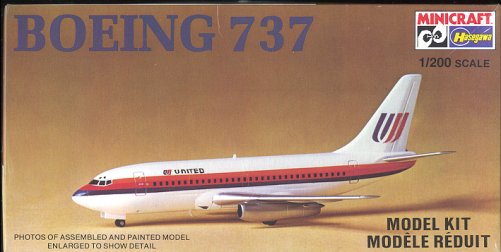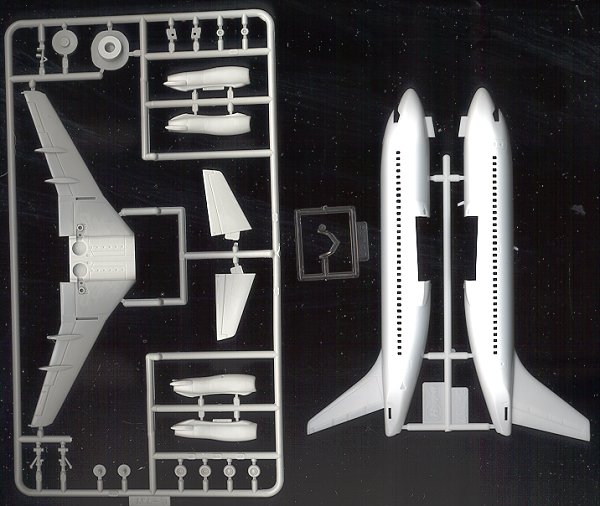
|
KIT: |
Minicraft/Hasegawa 1/200 B.737-200 |
|
KIT # |
1156 |
|
PRICE: |
$5.00 when new |
|
DECALS: |
United Airlines |
|
REVIEWER: |
Scott Van Aken |
|
NOTES: |
No stand included |

|
HISTORY |
Changes include a larger wing, higher cruise speed, increased range, and new engines with improvements in noise, fuel burn and thrust. With over 3,300 orders the Boeing 737 has become the world's all time best-selling commercial jetliner. Over 2,700 have already been delivered to more than 250 customers in 95 countries. By 1996, 737s had carried more than 4.3 billion passengers and flown more than 26.6 billion miles. Over 700 737s are in the sky at all times.
|
THE KIT |

Hasegawa has had very good response to its series of 1/200 airliners that were initially boxed as 'Love Liners'. The smallest that they have ever done has been the C-47/DC-3, which is really quite small in this scale. Prior to that, the DC-9-30 and B.737-200 were the smallest that they've done. Though the Minicraft boxing doesn't come with a stand, those marketed by Hasegawa generally do. To be more amenable to the US market, Minicraft reboxed the airliner kits with new (and boring) boxes and US airline liveries. The 737-200, one of the most widely built and used medium haul airliners around, was boxed with United livery.
The kit itself is pretty basic and an excellent introduction kit to the wonderful world of airliner modelling. As it is 1/200 scale, it takes up very little space on a display shelf. The main fuselage is molded in white with the rest of the kit in a medium grey. Panel lines are raised, other than the doors and control surfaces. There are no cabin windows, but a cockpit transparency is provided. A large plastic bulkhead is also given which provides sufficient weight to keep it on all three gear, a trait of even the largest 747 kits in this series.
The plastic is free from flash and sink areas, which includes the one piece wing and tailplanes. There are a few ejector pin marks, but they will be hidden once the kit s built. There is no wheels up option and making an in-flight model will require cutting off the nose gear doors and removing the main gear strut attachment points at a minimum. The engine has a compressor face for the intake and exhaust to prevent any see through effect.
 Instructions
are copies of the Japanese ones and modified in terms of markings and
having the write up in English. Color information is provided in generic
colors with the decal placement guide. It is basically a white fuselage
with medium grey flying surfaces and bare metal engine covers and leading
edges. The decals are by Scalemaster and though slightly off register
(what else is new), are colorful and go on easily. There are a number of
aftermarket decals available for this and most of the other airliners in
this scale.
Instructions
are copies of the Japanese ones and modified in terms of markings and
having the write up in English. Color information is provided in generic
colors with the decal placement guide. It is basically a white fuselage
with medium grey flying surfaces and bare metal engine covers and leading
edges. The decals are by Scalemaster and though slightly off register
(what else is new), are colorful and go on easily. There are a number of
aftermarket decals available for this and most of the other airliners in
this scale.
|
CONCLUSIONS |
I've built a number of these kits and can tell you that they are about as trouble free as you'll find. These are even quite suitable for the beginner as long as he/she can handle the small bits like the wheels. If you've not tried an airliner, these would be an excellent first time kit for you.
If you would like your product reviewed fairly and quickly by a site that has over 200,000 visitors a month, please contact me or see other details in the Note to Contributors.